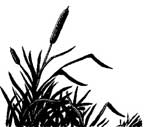 |
Dr. Gouin's Bay Gardener |
 Cattails Bring Autumn into Your Home
Cattails Bring Autumn into Your Home
But you must preserve them properly lest they fill the house with great globs of fluff
While canoeing down Rockhold Creek, I spotted some beautiful cattails along the banks. I cut a dozen to bring in for autumn decoration. However, unless they are properly preserved, they will rupture by about mid-December and fill the house with great globs of fluff.
Use one of two methods to preserve cattails indefinitely. For either way to work, the cattails should be dry.
One way is to dip them into a diluted solution of Elmer’s glue. Add one part Elmer’s glue to nine parts water and mix thoroughly. I’ve made the ideal dipping container from a 24-inch piece of plastic pipe with a cap glued to one end. Others use one of those half-moon dishes for holding and buttering individual cobs of corn.
To seal the cattails in diluted Elmer’s glue, dip or slowly spin each cattail in the container for a few seconds. Stand each cattail separately so they do not touch each other until they dry, which may require eight to 10 hours depending on the humidity.
Use this method, and your cattails won’t be shiny after they dry.
The other method of preserving cattails is to spray them with a cheap hair spray rich in lacquer. The cheaper the hair spray, the better. If you are going to treat several cattails, spray outdoors to avoid inhaling the fumes. Next stand them separately until they dry, usually in less than an hour.
The ideal container for standing cattails upright after treatment is a pail of sand. One pail of sand can support many cattails.
Beating Bermuda Grass
Q My lawn is being taken over with what I call wire grass. I keep pulling it out, but it is a losing battle. What is the disadvantage of just letting it take over? Thanks in advance.
—Ruth Hanson, Annapolis
A If you cut your grass at two inches or less, you encourage Bermuda grass to take over. You can encourage more Bermuda grass growth by fertilizing in May, June and July. Eventually the Bermuda grass will take over everything, including your garden. Once it takes over, it will also attract billbugs, and you will have to spray to control that insect. Bermuda grass is a very tough grass. However, it will not tolerate growing in shade. It will also all turn brown in late fall and will not resume a normal green color until May.
To win the battle, read the lawn columns I’ve written for Bay Weekly last spring and again this late summer and autumn. View past columns at www.bayweekly.com/archives/2005.html. Select an issue, then see Bay Gardener.
Ask Dr. Gouin your questions at [email protected]. All questions will appear in Bay Weekly. Please include your name and address.

